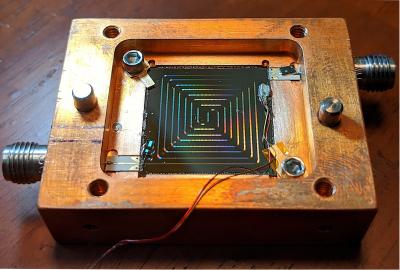NIST sensor experts invent supercool mini thermometer

Two of NIST's superconducting thermometers for measuring cryogenic temperatures are glued to the lower left and upper right of this amplifier. The miniature thermometers, made of niobium on a layer of silicon dioxide, measure the temperature of the amplifier or other device based on a frequency signal.
Credit: Wheeler/NIST
Researchers at the National Institute of Standards and Technology (NIST) have invented a miniature thermometer with big potential applications such as monitoring the temperature of processor chips in superconductor-based quantum computers, which must stay cold to work properly.
NIST’s superconducting thermometer measures temperatures below 1 Kelvin (minus 272.15 ?C or minus 457.87 ?F), down to 50 milliKelvin (mK) and potentially 5 mK. It is smaller, faster and more convenient than conventional cryogenic thermometers for chip-scale devices and could be mass produced. NIST researchers describe the design and operation in a new journal paper [https:/
Just 2.5 by 1.15 millimeters in size, the new thermometer can be embedded in or stuck to another cryogenic microwave device to measure its temperature when mounted on a chip. The researchers used the thermometer to demonstrate fast, accurate measurements of the heating of a superconducting microwave amplifier.
The technology is a spinoff of NIST’s custom superconducting sensors for telescope cameras, specifically microwave detectors delivered for the BLAST balloon [https:/
“This was a fun idea that quickly grew into something very helpful,” group leader Joel Ullom said. “The thermometer allows researchers to measure the temperature of a wide range of components in their test packages at very little cost and without introducing a large number of additional electrical connections. This has the potential to benefit researchers working in quantum computing or using low-temperature sensors in a wide range of fields.”
The thermometer consists of a superconducting niobium resonator coated with silicon dioxide. The coating interacts with the resonator to shift the frequency at which it naturally vibrates. Scientists suspect this is due to atoms “tunneling” between two sites, a quantum-mechanical effect.
The NIST thermometer is based on a new application of the principle that the natural frequency of the resonator depends on the temperature. The thermometer maps changes in frequency, as measured by electronics, to a temperature. By contrast, conventional thermometers for sub-Kelvin temperatures are based on electrical resistance. They require wiring routed to room-temperature electronics, adding complexity and potentially causing heating and interference.
The NIST thermometer measures temperature in about 5 milliseconds (thousandths of a second), much faster than most conventional resistive thermometers at about one-tenth of a second. The NIST thermometers are also easy to fabricate in only a single process step. They can be mass produced, with more than 1,200 fitting on a 3-inch (approximately 75-millimeter) silicon wafer.
###
Paper:
J. Wheeler, M.R. Vissers, M. Malnou, J. Hubmayr, J.N. Ullom, and J. Gao. Sub-Kelvin Thermometer for On-Chip Measurements of Microwave Devices Utilizing Two-Level Systems in Superconducting Microresonators. Applied Physics Letters 117, 192601 (2020). DOI: 10.1063/5.0029351 [https:/
All latest news from the category: Power and Electrical Engineering
This topic covers issues related to energy generation, conversion, transportation and consumption and how the industry is addressing the challenge of energy efficiency in general.
innovations-report provides in-depth and informative reports and articles on subjects ranging from wind energy, fuel cell technology, solar energy, geothermal energy, petroleum, gas, nuclear engineering, alternative energy and energy efficiency to fusion, hydrogen and superconductor technologies.
Newest articles

Pinpointing hydrogen isotopes in titanium hydride nanofilms
Although it is the smallest and lightest atom, hydrogen can have a big impact by infiltrating other materials and affecting their properties, such as superconductivity and metal-insulator-transitions. Now, researchers from…

A new way of entangling light and sound
For a wide variety of emerging quantum technologies, such as secure quantum communications and quantum computing, quantum entanglement is a prerequisite. Scientists at the Max-Planck-Institute for the Science of Light…

Telescope for NASA’s Roman Mission complete, delivered to Goddard
NASA’s Nancy Grace Roman Space Telescope is one giant step closer to unlocking the mysteries of the universe. The mission has now received its final major delivery: the Optical Telescope…



